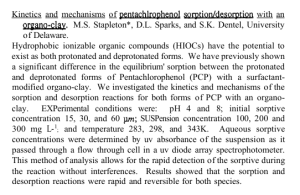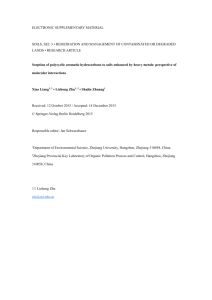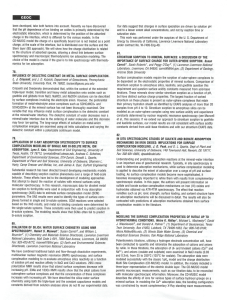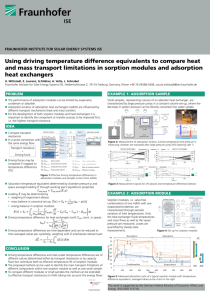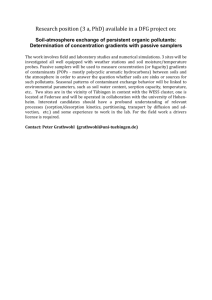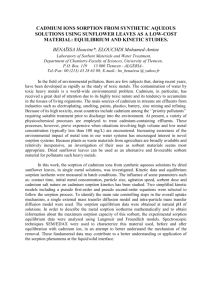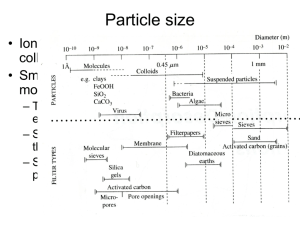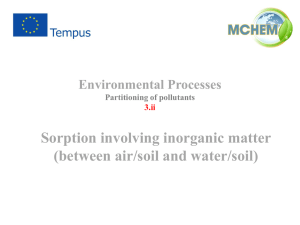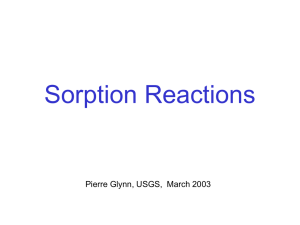Sorption processes in soil
advertisement
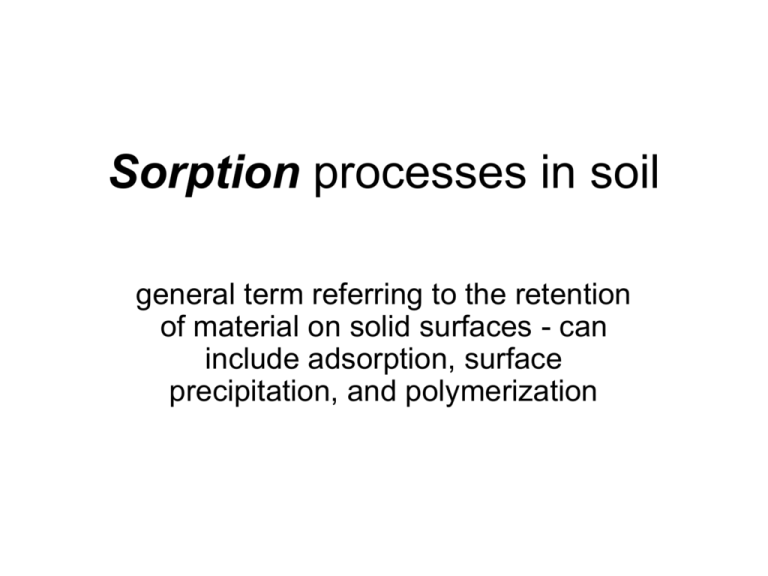
Sorption processes in soil general term referring to the retention of material on solid surfaces - can include adsorption, surface precipitation, and polymerization I. Adsorption - terminology • Accumulation of a substance between a solid surface and the solution. • Not including surface precipitation and/or polymerization. • Different from absorption which refers to ingestion or uptake into a plant or solid body. sorbate sorptive sorbent Why study sorption? Important chemical process in soil affecting nutrients, contaminants,… http://www.btny.purdue.edu/Pubs/PPP/images/PPP-35.fatestransfer.jpg Factors affecting the fate of soil-applied herbicides www.montana.edu/wwwpb/pubs/mt200405.html Forces involved in Adsorption • Physical forces (distance and valence) a. van der Waals (weak electrostatic forces between nonpolar molecules due to temporary dipole moment) b. Electrostatic complexes (e.g., ion exchange) • Chemical forces (electron reconfiguration; breaking/making bonds) a. inner-sphere complexation (ligand exchange, covalent/ionic bonding, aka chemisorption or specific sorption) http://www.columbia.edu/cu/biology/courses/c2005/images/vdw.gif Ion Exchange (electrostatic complex) http://www.mpi-muelheim.mpg.de/kofo/ institut/arbeitsbereiche/schueth/grafik/z_ion_exchange.gif Silica-based material being attacked by water. The process involves water physisorption (charge attraction) onto the surface, followed by chemical reactions with the surface (chemisorption) that break structural bonds. http://www.mri.psu.edu/faculty/pantano/group/leed/research.htm II. Surface Functional Groups, (chemically reactive molecular unit on a solid surface) • Organic: carboxyl, carbonyl, phenolic Inorganic SFG’s • • O atoms of the silica tetrahedral layer (siloxane surface) in the interlayer region of phyllosilicates OH groups associated with edges of minerals http://surface.chem.uwm.edu/tysoe/research/Crown.gif Uranium Adsorption on Soils SFG’s www.dartmouth.edu/~soilchem/uranium.htm SFG's can be protonated or deprotonated by reaction in water to form exchange sites: S-OH + H+ ↔ S-OH2+ (gains protons) S-OH ↔ S-O- + H+ (loses protons) S-OH + OH- ↔S-O- + H2O (loses protons) protonation deprotonation deprotonation Surface Functional Groups on Soil Organic Matter www.humet.hu/141-vizsgalat-en.shtml III. Surface Complexes: SFG + ion or molecule in solution = stable molecular entity, called a surface complex. A. Outer-sphere complex - water molecule is present between the SFG and bound (adsorbed) ion or molecule. Also includes Diffuse Ion Swarms in solution. B. Inner-sphere complex - no water molecule present between the SFG and bound ion or molecule. C. Inner and outer-sphere complexation occurs simultaneously (i.e. not mutually exclusive). Outer Sphere Complex • • • • • weak (H-bonding) electrostatic interaction, thus surface must be charged rapid reversible (exchangeable) affected by ionic strength of the solution Inner-Sphere Complex • • • • • • • Strong (covalent and/or ionic bonding) Mono- or polydentate (held by one or more bonds) May be slower than outer sphere complexation Often irreversible or “fixed” depending upon environmental conditions Weakly affected by solution ionic strength Surface charge can be changed by complexation Charged surface is not required for complexation Omoike A., J. Chorover, K. Kwon, and J.D. Kubicki (2004) Adhesion of bacterial exopolymers to FeOOH: Inner-sphere complexation of phosphodiester groups www.geosc.psu.edu/envchem/2.3.htm IV. Adsorption Isotherms Conducting sorption experiments Sorption experiments • Equilibrate sorptive (chemical) with sorbent (soil) – Same Temperature and Pressure – Control or measure Ionic strength and pH • Batch equilibrium experiments • Column or flow-through experiments Batch equilibration – unrealistic but easy, fast, common, maximum “q” • Shake or stir soil with solution containing chemical of interest (sorptive) – Shaking or stirring too long may cause minerals to dissolve, weather, and/or precipitate new minerals – Insufficient mixing means that all surface functional groups may not be reached – Overly vigorous mixing may break minerals and expose new functional groups on edges Batch sorption experiments Solution + soil 0 1 5 10 … 100 mM + Blanks Include a range of sorptive concentrations in a buffer. Keep as many variables the same to measure sorption. Sorption experiments 1. Equilibrate sorbent (soil) with sorptive (chemical in solution over reasonable range) 2. Measure solution composition and volume before and after equilibration 3. Control or measure I, pH, T, and P ALWAYS RUN BLANKS throughout experiment 4. Separate solution from soil by centrifugation, settling, or filtering; or collect leachate 5. Calculate sorption (q) by mass balance and plot Flow or column experiments • Pass solution through soil and collect leachate. – Columns can be packed or collected directly from soil. No standard size or flow rate. • Problems include macropores, cracks, inadequate exposure of sorptive to all functional groups. – Column size and packing affects results http://www.clemson.edu/agbioeng/bio/images/sumint/fen3.jpg http://www.soilmeasurement.com/images/Tempe_cell.jpg http://www.sce.ait.ac.th/facilities/irrlab/images/Imagep30c.jpg http://www.hydrogeologie.tu-berlin.de/_data/images/sv2.jpg
